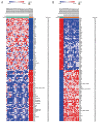Sex Differences in Osteoarthritis Pathogenesis: A Comprehensive Study Based on Bioinformatics
- PMID: 32255771
- PMCID: PMC7163332
- DOI: 10.12659/MSM.923331
Sex Differences in Osteoarthritis Pathogenesis: A Comprehensive Study Based on Bioinformatics
Abstract
BACKGROUND Osteoarthritis (OA) is a common disorder in the elderly. OA influences the daily life of patients and has become a worldwide health problem. It is still unclear whether the pathogenesis mechanism is different between males and females. This study investigated the differentially expressed genes (DEGs) and explored the different signaling pathways of OA between males and females. MATERIAL AND METHODS Data sets of GSE55457, GSE55584, and GSE12021 were retrieved from Gene Expression Omnibus to conduct DEGs analysis. Enrichment analysis of Kyoto Encyclopedia of Genes and Genomes pathway and Gene Ontology term was performed using the Database for Annotation, Visualization and Integrated Discovery (DAVID) bioinformatics tool. The protein interaction network was constructed in Cytoscape 3.7.2. qRT-PCR was then performed to validate the expression of hub genes in OA patients and healthy people. RESULTS In total, 4 co-upregulated and 10 co-downregulated genes were identified. We found that enriched pathways were different between males and females. BCL2L1, EEF1A1, EEF2, HNRNPD, and PABPN1 were considered as hub genes in OA pathogenesis in males, while EEF2, EEF1A1, RPL37A, FN1 were considered as hub genes in OA pathogenesis in females. Consistent with the bioinformatics analysis, the qRT-PCR analysis also showed that the gene expression of BCL2L1, HNRNPD, and PABPN1 was significantly lower in male OA patients. In contrast, EEF2, EEF1A1, and RPL37A were significantly lower in female OA patients. CONCLUSIONS The DEGs identified may be involved in different OA disease progression mechanisms between males and females, and they are considered as treatment targets or prognosis markers for males and females. The pathogenesis mechanism is sex-dependent.
Conflict of interest statement
None.
Figures







Similar articles
-
Identification of genes and pathways in the synovia of women with osteoarthritis by bioinformatics analysis.Mol Med Rep. 2018 Mar;17(3):4467-4473. doi: 10.3892/mmr.2018.8429. Epub 2018 Jan 15. Mol Med Rep. 2018. PMID: 29344651 Free PMC article.
-
Identification of Key Genes and Pathways Associated with Sex Differences in Osteoarthritis Based on Bioinformatics Analysis.Biomed Res Int. 2019 Dec 6;2019:3482751. doi: 10.1155/2019/3482751. eCollection 2019. Biomed Res Int. 2019. PMID: 31886203 Free PMC article.
-
Bioinformatics analysis to identify key genes and pathways influencing synovial inflammation in osteoarthritis.Mol Med Rep. 2018 Dec;18(6):5594-5602. doi: 10.3892/mmr.2018.9575. Epub 2018 Oct 23. Mol Med Rep. 2018. PMID: 30365099 Free PMC article.
-
Text Mining and Hub Gene Network Analysis of Endometriosis.Biomed Res Int. 2021 Dec 7;2021:5517145. doi: 10.1155/2021/5517145. eCollection 2021. Biomed Res Int. 2021. PMID: 34917684 Free PMC article. Review.
-
Sex Specific Determinants in Osteoarthritis: A Systematic Review of Preclinical Studies.Int J Mol Sci. 2020 May 24;21(10):3696. doi: 10.3390/ijms21103696. Int J Mol Sci. 2020. PMID: 32456298 Free PMC article.
Cited by
-
The Regulatory Role of Ferroptosis in Bone Homeostasis.Stem Cells Int. 2022 Jul 13;2022:3568597. doi: 10.1155/2022/3568597. eCollection 2022. Stem Cells Int. 2022. PMID: 35873534 Free PMC article. Review.
-
Therapeutic potential of Coptis chinensis for arthritis with underlying mechanisms.Front Pharmacol. 2023 Aug 11;14:1243820. doi: 10.3389/fphar.2023.1243820. eCollection 2023. Front Pharmacol. 2023. PMID: 37637408 Free PMC article. Review.
-
Advancing osteoarthritis therapy with GMOCS hydrogel-loaded BMSCs-exos.J Nanobiotechnology. 2024 Aug 19;22(1):493. doi: 10.1186/s12951-024-02713-z. J Nanobiotechnology. 2024. PMID: 39160590 Free PMC article.
-
Prevalence and Incidence of Osteoarthritis: A Population-Based Retrospective Cohort Study.J Clin Med. 2021 Sep 21;10(18):4282. doi: 10.3390/jcm10184282. J Clin Med. 2021. PMID: 34575394 Free PMC article.
-
Transcriptomics and metabolomics: Challenges of studying obesity in osteoarthritis.Osteoarthr Cartil Open. 2024 May 4;6(3):100479. doi: 10.1016/j.ocarto.2024.100479. eCollection 2024 Sep. Osteoarthr Cartil Open. 2024. PMID: 38774038 Free PMC article.
References
MeSH terms
Substances
LinkOut - more resources
Full Text Sources
Medical
Research Materials
Miscellaneous

